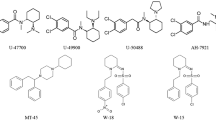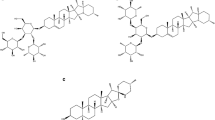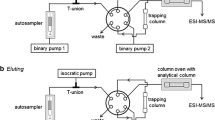Abstract
2-Amino-5-chloropyridine (ACP) is a degradation product of zopiclone (ZOP) and its two main metabolites N-desmethylzopiclone (NDZOP) and zopiclone N-oxide (ZOPNO). ACP may be formed when specimens are stored. ZOP instability in blood makes interpretation of concentrations difficult especially in cases of prolonged sample storage. This study investigated how ACP could be used to estimate the original concentration of ZOP in authentic samples. For that purpose, an analytical liquid chromatography tandem mass spectrometry (LC-MS/MS) method for the quantitation of ACP, ZOP, and NDZOP in blood was developed and validated. Due to poor extraction recovery, ZOPNO was not included in the analytical method. The method was then applied to investigate ACP formation, ZOP and NDZOP degradation in stored ZOP post-dosed authentic whole blood and two mathematical models were used to calculate the original concentration of ZOP. During storage, ACP was formed in amounts equimolar to the ZOP and NDZOP degradation. Results from samples in which ACP had been formed were used to test two models to estimate the original ZOP concentration. The correlation tests of the models showed strong correlations to the original ZOP concentration (r = 0.960 and r = 0.955) with p < 0.01 and explained more than 90 % of the ZOP concentration. This study showed that the equimolar degradation of ZOP and NDZOP to ACP could be used to estimate the original concentration of ZOP.



Similar content being viewed by others
References
Mannaert E, Tytgat J, Daenens P (1997) Detection of 2-amino-5-chloropyridine in urine as a parameter of zopiclone (Imovane) intake using HPLC with diode array detection. J Anal Toxicol 21:208–212
Nilsson GH, Kugelberg FC, Ahlner J, Kronstrand R (2014) Quantitative analysis of zopiclone, N-desmethylzopiclone, zopiclone N-oxide and 2-amino-5-chloropyridine in urine using LC-MS-MS. J Anal Toxicol. doi:10.1093/jat/bku042
Jantos R, Vermeeren A, Sabljic D, Ramaekers JG, Skopp G (2013) Degradation of zopiclone during storage of spiked and authentic whole blood and matching dried blood spots. Int J Legal Med 127:69–76
Galloway JH, Marsh ID, Newton CM, Forrest AR (1999) A method for the rapid detection of the zopiclone degradation product 2-amino-5-chloropyridine. Sci Justice 39:253–256
Fernandez C (1995) Degradation and racemisation of zopiclone enantiomers in plasma and partially aqueous solutions. Chirality 7:267–271
Nilsson GH, Kugelberg FC, Kronstrand R, Ahlner J (2010) Stability tests of zopiclone in whole blood. Forensic Sci Int 200:130–135
Nilsson GH, Kugelberg FC, Ahlner J, Kronstrand R (2011) Influence of pre-analytical conditions on the interpretation of zopiclone concentrations in whole blood. Forensic Sci Int 207:35–39
Holmgren P, Druid H, Holmgren A, Ahlner J (2004) Stability of drugs in stored postmortem femoral blood and vitreous humor. J Forensic Sci 49:820–825
Mistri HN, Jangid AG, Pudage A, Shrivastav P (2008) HPLC-ESI-MS/MS validated method for simultaneous quantification of zopiclone and its metabolites, N-desmethyl zopiclone and zopiclone-N-oxide in human plasma. J Chromatogr B Analyt Technol Biomed Life Sci 864:137–148
Jones AW, Holmgren A, Kugelberg FC (2007) Concentrations of scheduled prescription drugs in blood of impaired drivers: considerations for interpreting the results. Ther Drug Monit 29:248–260
Gustavsen I, Al-Sammurraie M, Morland J, Bramness JG (2009) Impairment related to blood drug concentrations of zopiclone and zolpidem compared to alcohol in apprehended drivers. Accid Anal Prev 41:462–466
Vindenes V, Lund HM, Andresen W, Gjerde H, Ikdahl SE et al (2012) Detection of drugs of abuse in simultaneously collected oral fluid, urine and blood from Norwegian drug drivers. Forensic Sci Int 219:165–171
Jones AW, Holmgren A (2012) Concentrations of zolpidem and zopiclone in venous blood samples from impaired drivers compared with femoral blood from forensic autopsies. Forensic Sci Int 222:118–123
Jones AW, Holmgren A, Ahlner J (2012) Toxicological analysis of blood and urine samples from female victims of alleged sexual assault. Clin Toxicol (Phila) 50:555–561
Gaillot J, Heusse D, Hougton GW, Marc Aurele J, Dreyfus JF (1983) Pharmacokinetics and metabolism of zopiclone. Pharmacology 27(Suppl 2):76–91
Fernandez C, Martin C, Gimenez F, Farinotti R (1995) Clinical pharmacokinetics of zopiclone. Clin Pharmacokinet 29:431–441
Gunja N (2013) The clinical and forensic toxicology of Z-drugs. J Med Toxicol 9:155–162
El-Shaheny RN, Alattas A, Nasr JJ, El-Enany N, Belal F (2012) Simultaneous determination of zopiclone and its degradation product and main impurity (2-amino-5-chloropyridine) by micellar liquid chromatography with time-programmed fluorescence detection: preliminary investigation for biological monitoring. J Chromatogr B Analyt Technol Biomed Life Sci 907:49–55
Peters FT, Drummer OH, Musshoff F (2007) Validation of new methods. Forensic Sci Int 165:216–224
Gebauer MG, Alderman CP (2002) Validation of a high-performance liquid chromatographic method for the enantiospecific quantitation of zopiclone in plasma. Biomed Chromatogr 16:241–246
Tonon MA, Jabor VA, Bonato PS (2011) Enantioselective analysis of zopiclone and its metabolites in plasma by liquid chromatography/tandem mass spectrometry. Anal Bioanal Chem 400:3517–3525
Acknowledgments
The authors would like to thank the National Board of Forensic Medicine and the Centre of Forensic Science Linköping University for providing resources for this study.
Conflict of interest
There were no external sources of funding for this project. None of the authors consider that any conflicts of interest exist.
Author information
Authors and Affiliations
Corresponding author
Rights and permissions
About this article
Cite this article
Nilsson, G.H., Kugelberg, F.C., Ahlner, J. et al. Validation of an LC-MS/MS method for the determination of zopiclone, N-desmethylzopiclone and 2-amino-5-chloropyridine in whole blood and its application to estimate the original zopiclone concentration in stored specimens. Int J Legal Med 129, 269–277 (2015). https://doi.org/10.1007/s00414-014-1049-2
Received:
Accepted:
Published:
Issue Date:
DOI: https://doi.org/10.1007/s00414-014-1049-2




